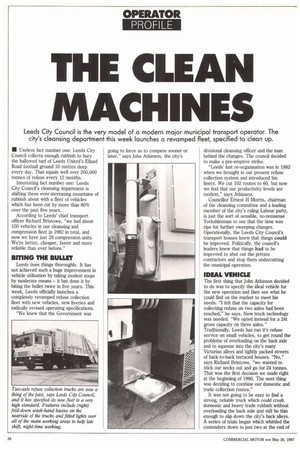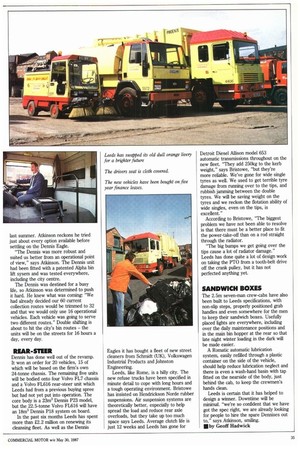THE CLEAN
Page 36

Page 37

If you've noticed an error in this article please click here to report it so we can fix it.
MACHINES
Leeds City Council is the very model of a modern major municipal transport operator. The city's cleansing department this week launches a revamped fleet, specified to clean up.
• Useless fact number one: Leeds City Council collects enough rubbish to bury the hallowed turf of Leeds United's Elland Road football ground 10 metres deep every day. That equals well over 200,000 tonnes of refuse every 12 months.
Interesting fact number one: Leeds City Council's cleansing department is shifting these ever-increasing mountains of rubbish about with a fleet of vehicles which has been cut by more than 80% over the past five years.
According to Leeds' chief transport officer Richard Bristowe, "we had about 150 vehicles in our cleansing and compression fleet in 1982 in total, and now we have just 28 compression units. We're better, cheaper, faster and more reliable than ever before."
BMNG TFIE BULLET
Leeds does things thoroughly. It has not achieved such a huge improvement in vehicle utilisation by taking modest steps by moderate means — it has done it by biting the bullet twice in five years. This week, Leeds officially launches a completely revamped refuse collection fleet with new vehicles, new liveries and radically revised operating specifications.
"We knew that the Government was going to force us to compete sooner or later," says John Atkinson, the city's divisional cleansing officer and the man behind the changes. The council decided to make a pre-emptive strike.
"Leeds' last re-organisation was in 1982 when we brought in our present refuse collection system and introduced bin liners. We cut 102 routes to 60, but now we feel that our productivity levels are modest," says Atkinson.
Councillor Ernest H Morris, chairman of the cleansing committee and a leading member of the city's ruling Labour party, is just the sort of sensible, no-nonsense Yorkshireman to see that the time was ripe for further sweeping changes. Operationally, the Leeds City Council's transport bosses knew that things could be improved. Politically, the council's leaders knew that things had to be improved to shut out the private contractors and stop them undercutting the municipal operation.
IDEAL VEHICLE
The first thing that John Atkinson decided to do was to specify the ideal vehicle for the new operation and then see what he could find on the market to meet his needs. "I felt that the capacity for collecting refuse on two axles had been reached," he says. New truck technology was needed. "We opted instead for a 24t gross capacity on three axles." Traditionally, Leeds has run it's refuse service on small vehicles, to get round the problems of overloading on the back axle and to squeeze into the city's many Victorian alleys and tightly packed streets of back-to-back terraced houses. "No," says Richard Bristowe, "we wanted to stick our necks out and go for 24 tonnes. That was the first decision we made right at the beginning of 1986. The next thing was deciding to combine our domestic and trade collection routes."
It was not going to be easy to find a strong, reliable truck which could crush domestic and heavy trade rubbish without overloading the back axle and still be thin enough to slip down the city's back alleys. A series of trials began which whittled the contenders down to just two at the end of
last summer. Atkinson reckons he tried just about every option available before settling on the Dennis Eagle.
"The Dennis was more robust and suited us better from an operational point of view," says Atkinson. The Dennis unit had been fitted with a patented Alpha bin lift sysem and was tested everywhere, including the city centre.
The Dennis was destined for a busy life, so Atkinson was determined to push it hard. He knew what was coming: "We had already decided our 60 current collection routes would be trimmed to 32 and that we would only use 16 operational vehicles. Each vehicle was going to serve two different routes." Double shifting is about to hit the city's bin routes — the units will be on the streets for 16 hours a day, every day.
REAR-STEER
Dennis has done well out of the revamp. It won an order for 20 vehicles, 15 of which will be based on the firm's own 24-tonne chassis. The remaining five units will be bodied onto four Volvo FL7 chassis and a Volvo FL616 rear-steer unit which Leeds had from a previous buying spree but had not yet put into operation. The core body is a 23m3 Dennis P23 model, but the 22.5-tonne Volvo FL616 will have an 18m3 Dennis P18 system on board.
In the past six months Leeds has spent more than 22.2 million on renewing its cleansing fleet. As well as the Dennis Eagles it has bought a fleet of new street cleaners from Schmidt (UK), Volkswagen Industrial Products and Johnston Engineering.
Leeds, like Rome, is a hilly city. The new refuse trucks have been specified in minute detail to cope with long hours and a tough operating environment. Bristowe has insisted on Hendrickson Norde rubber suspensions. Air suspension systems are theoretically better, especially to help spread the load and reduce rear axle overloads, but they take up too much space says Leeds. Average clutch life is just 12 weeks and Leeds has gone for Detroit Diesel Allison model 653 automatic transmissions throughout on the new fleet. "They add 250kg to the kerb weight," says Bristowe, "but they're more reliable. We've gone for wide single tyres as well. We used to get terrible tyre damage from running over to the tips, and rubbish jamming between the double tyres. We will be saving weight on the tyres and we reckon the flotation ability of wide singles, even on the tips, is excellent."
According to Bristowe, "The biggest problem we have not been able to resolve is that there must be a better place to fit the power-take-off than on a rod straight through the radiator.
"The big bumps we get going over the tips cause a lot of radiator damage." Leeds has done quite a lot of design work on taking the PTO from a tooth-belt drive off the crank pulley, but it has not perfected anything yet
SANDWICH BOXES
The 2.5m seven-man crew-cabs have also been built to Leeds specifications, with non-slip steps, properly positioned grab handles and even somewhere for the men to keep their sandwich boxes. Usefully placed lights are everywhere, including over the daily maintenance positions and in the main bin hopper at the rear so that late night winter loading in the dark will be made easier.
A Romatic automatic lubrication system, easily refilled through a plastic container on the side of the vehicle, should help reduce lubrication neglect and there is even a wash-hand basin with tap fitted on the nearside of the body, just behind the cab, to keep the crewmen's hands clean.
Leeds is certain that it has helped to design a winner. Downtime will be minimal. "we're so confident that we have got the spec right, we are already looking for people to hire the spare Demises out to," says Atkinson, smiling.
III by Geoff Hadwick












































































